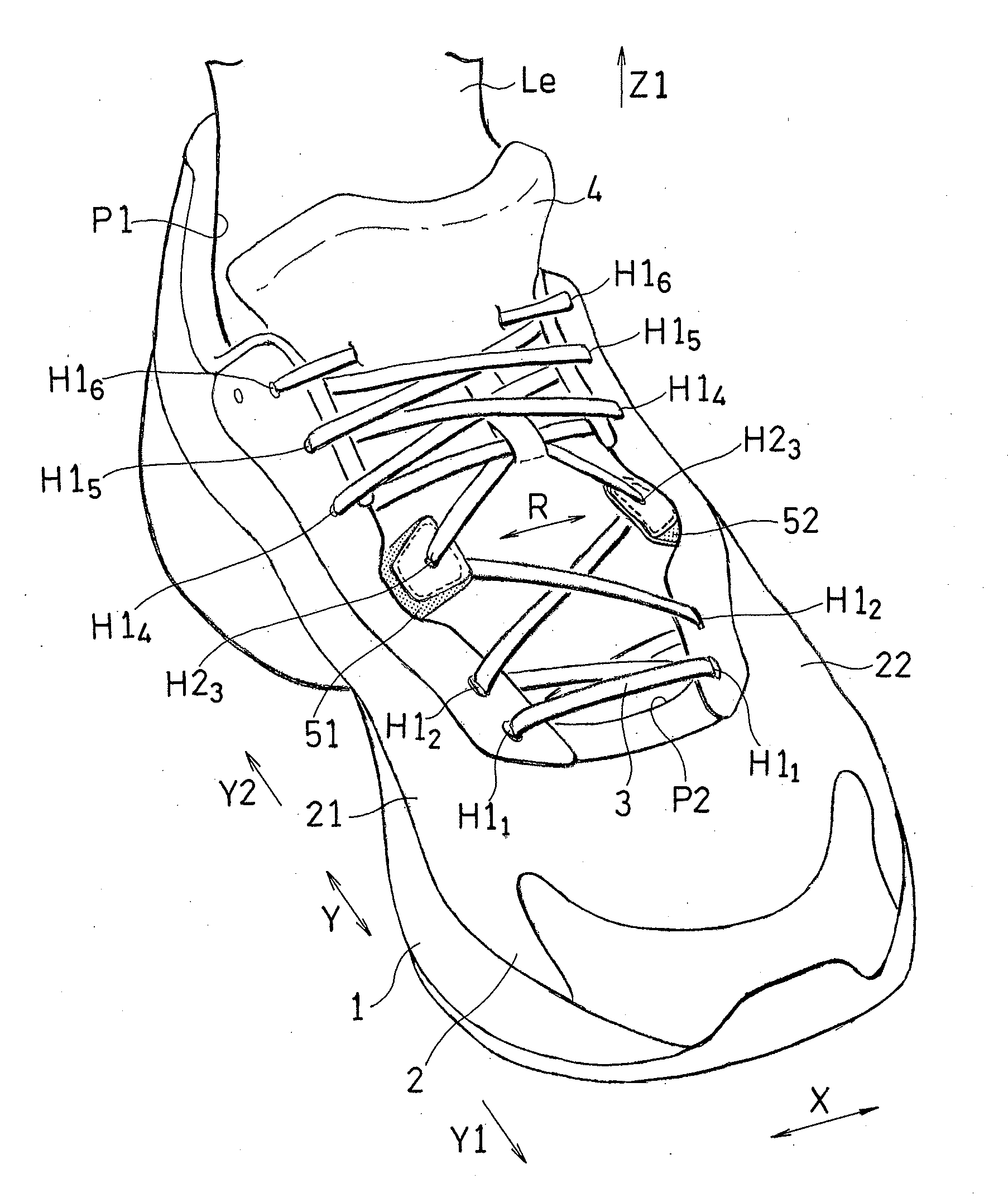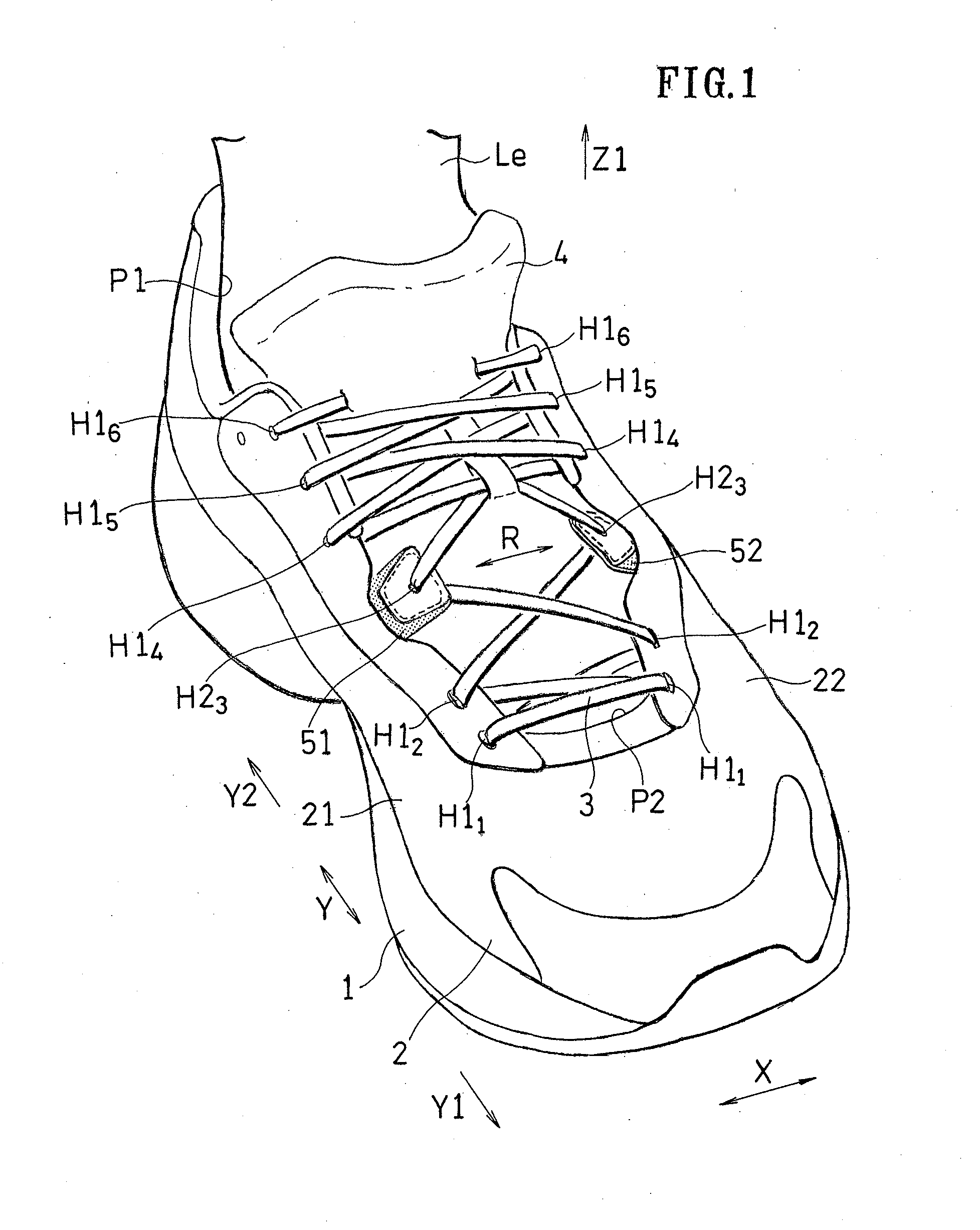Shoe having lace fitting structure
a technology of lace fitting and lace, which is applied in the direction of fastenings, uppers, bootlegs, etc., can solve the problems that the wide stretchable piece cannot support the side surface of the foot, and achieve the effects of small flexural rigidity, easy shrinkage, and easy shrinkag
- Summary
- Abstract
- Description
- Claims
- Application Information
AI Technical Summary
Benefits of technology
Problems solved by technology
Method used
Image
Examples
embodiments
[0148]The present invention will be understood more clearly from the following description of preferred embodiments taken in conjunction with the accompanying drawings. Note however that the embodiments and the drawings are merely illustrative, and the scope of the present invention shall be defined by the appended claims. In the accompanying drawings, like reference numerals denote like components throughout the plurality of figures.
first embodiment
[0149]A first embodiment of the present invention will now be described with reference to FIGS. 1 to 9.
[0150]A shoe for the left foot will be illustrated in the following description. In the following figures, the arrow OUT represents the lateral side direction of the foot, and the arrow IN represents the medial side direction of the foot.
[0151]General Structure of Shoe:
[0152]A shoe having a lace fitting structure shown in FIG. 1 includes a sole 1, an upper 2, and a shoelace 3.
[0153]The sole 1 is for absorbing an impact of landing. The upper 2 is for wrapping around the instep, and includes a tongue 4 (a portion of the main portion). The shoelace 3 is for fitting an upper 2 to the instep.
[0154]Although the end portions of the shoelace 3 are not shown in FIGS. 1 and 2, the end portions are firmly tied together after the foot is inserted into the upper 2. With the end portions of the shoelace 3 tied together, the upper 2 can tightly fit to the foot.
[0155]Note that the end portions of ...
second embodiment
[0184]FIGS. 10 and 11 show a second embodiment.
[0185]In the second embodiment, the main upper 2M includes a bag-like housing 29 for accommodating the middle portion 55 (movable portion) of the side panels 51 and 52. The tip portion 53 of the side panels 51 and 52 protrudes from the housing 29.
[0186]The medial and lateral side surfaces 21 and 22 of the main upper 2M of FIG. 11 are each formed by sewing together a front surface material 23 and a back surface material 24 as shown in FIG. 10. The housing 29 is formed between the two members 23 and 24 sewn together.
[0187]The side panels 51 and 52 are each formed in a band-like shape that conforms to the shape of the housing 29.
[0188]The side panels 51 and 52 may have a stretchable portion including the through holes 55h formed in the middle portion 55, as in the first embodiment, or may be formed by a resin tape having rubber elasticity instead of forming the through holes 55h.
[0189]The term “rubber elasticity” means a property of being...
PUM
 Login to View More
Login to View More Abstract
Description
Claims
Application Information
 Login to View More
Login to View More - R&D
- Intellectual Property
- Life Sciences
- Materials
- Tech Scout
- Unparalleled Data Quality
- Higher Quality Content
- 60% Fewer Hallucinations
Browse by: Latest US Patents, China's latest patents, Technical Efficacy Thesaurus, Application Domain, Technology Topic, Popular Technical Reports.
© 2025 PatSnap. All rights reserved.Legal|Privacy policy|Modern Slavery Act Transparency Statement|Sitemap|About US| Contact US: help@patsnap.com



